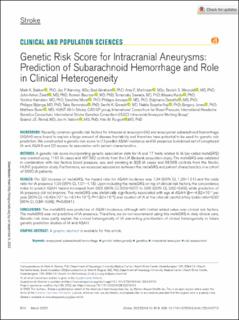Genetic Risk Score for Intracranial Aneurysms: Prediction of Subarachnoid Hemorrhage and Role in Clinical Heterogeneity
Bakker, Mark K.; Kanning, Jos P.; Abraham, Gad; Martinsen, Amy; Winsvold, Bendik Kristoffer Slagsvold; Zwart, John Anker Henrik; Bourcier, Romain; Sawada, Tomonobu; Koido, Masaru; Kamatani, Yoichiro; Morel, Sandrine; Amouyel, Philippe; Debette, Stéphanie; Bijlenga, Philippe; Berrandou, Takiy; Ganesh, Santhi K.; Bouatia-Naji, Nabila; Jones, Gregory; Bown, Matthew; Rinkel, Gabriel J.E.; Veldink, Jan H.; Ruigrok, Ynte M.; Aamodt, Anne Hege; Skogholt, Anne Heidi; Brumpton, Ben Michael; Willer, Cristen J.; Sandset, Else Charlotte; Kristoffersen, Espen Saxhaug; Ellekjær, Hanne; Heuch, Ingrid; Nielsen, Jonas Bille; Hagen, Knut; Hveem, Kristian; Fritsche, Lars; Thomas, Laurent Francois; Pedersen, Linda Margareth; Gabrielsen, Maiken Elvestad; Holmen, Oddgeir Lingaas; Børte, Sigrid; Schmidt, Helena; Stubhaug, Audun; Nielsen, Christopher Sivert; Johnsen, Marianne Bakke; Sandvei, Marie Søfteland
Peer reviewed, Journal article
Published version
Permanent lenke
https://hdl.handle.net/11250/3087833Utgivelsesdato
2023Metadata
Vis full innførselSammendrag
BACKGROUND: Recently, common genetic risk factors for intracranial aneurysm (IA) and aneurysmal subarachnoid hemorrhage
(ASAH) were found to explain a large amount of disease heritability and therefore have potential to be used for genetic risk
prediction. We constructed a genetic risk score to (1) predict ASAH incidence and IA presence (combined set of unruptured
IA and ASAH) and (2) assess its association with patient characteristics.
METHODS: A genetic risk score incorporating genetic association data for IA and 17 traits related to IA (so-called metaGRS)
was created using 1161 IA cases and 407 392 controls from the UK Biobank population study. The metaGRS was validated
in combination with risk factors blood pressure, sex, and smoking in 828 IA cases and 68 568 controls from the Nordic
HUNT population study. Furthermore, we assessed association between the metaGRS and patient characteristics in a cohort
of 5560 IA patients.
RESULTS: Per SD increase of metaGRS, the hazard ratio for ASAH incidence was 1.34 (95% CI, 1.20–1.51) and the odds
ratio for IA presence 1.09 (95% CI, 1.01–1.18). Upon including the metaGRS on top of clinical risk factors, the concordance
index to predict ASAH hazard increased from 0.63 (95% CI, 0.59–0.67) to 0.65 (95% CI, 0.62–0.69), while prediction of
IA presence did not improve. The metaGRS was statistically significantly associated with age at ASAH (β=−4.82×10−3 per
year [95% CI, −6.49×10−3 to −3.14×10−3
]; P=1.82×10 −8
), and location of IA at the internal carotid artery (odds ratio=0.92
[95% CI, 0.86–0.98]; P=0.0041).
CONCLUSIONS: The metaGRS was predictive of ASAH incidence, although with limited added value over clinical risk factors.
The metaGRS was not predictive of IA presence. Therefore, we do not recommend using this metaGRS in daily clinical care.
Genetic risk does partly explain the clinical heterogeneity of IA warranting prioritization of clinical heterogeneity in future
genetic prediction studies of IA and ASAH.

